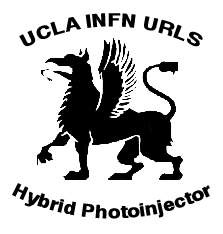
Finally the two systems designed separately (TW Section and SW Gun) are joined together and tuned for optimum performance. First, however, we have flashed back to an elegant but somewhat limited model designed using SuperFish.

This is the SuperFish initial tune of the hybrid gun, not that is helps us much, it was just nice to see. The black dot in the 5th cell is the driving point. SuperFish does not model input waveguides so HFSS was used to design the hybrid in full.

The piece de resistance as modeled in HFSS. We see on the right the SW gun coupled axial to an input cell which is used to split power between it and the downstream accelerating section. Importantly the so called "coupling cell" would have been there anyway on a TW linac, so we've not overly complicated the system to accomplish our goals. The only question which remains is whether or not we've succeeded in maintaining proper phase advance and field balance.


Reading the above from left to right, we see that we have maintained a 180 degree phase advance in the gun and 120 degree phase advance in the three downstream accelerating cavities. In the second graph we see close to balanced field in the gun and similar results in the traveling wave section. Of interest is the 90 degree phase advance between the standing wave section and coupling cell, between 0.2 and 0.4 on the first graph, which at present does not seem to be a function of the coupling cell parameters. The difference in field maximums is a function of the coupling cell parameters, most importantly the size of the iris looking into the gun, and thus the hybrid gun can be tuned before machining to fit any desired field level in the gun.

Interested persons are encouraged to look through the papers located in the Papers and Current Progess sections for a more detailed look at the RF operation of the Hybrid Photoinjector.
This page is updated and maintained by Brendan O'Shea of the UCLA PBPL Lab.